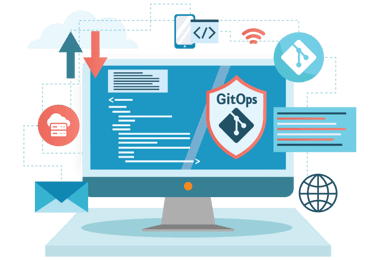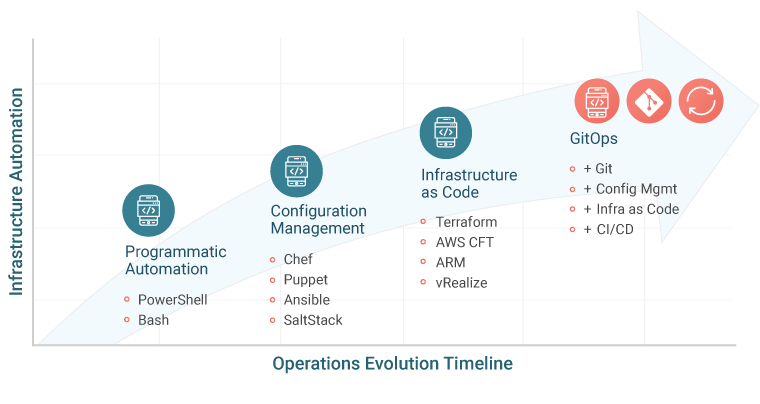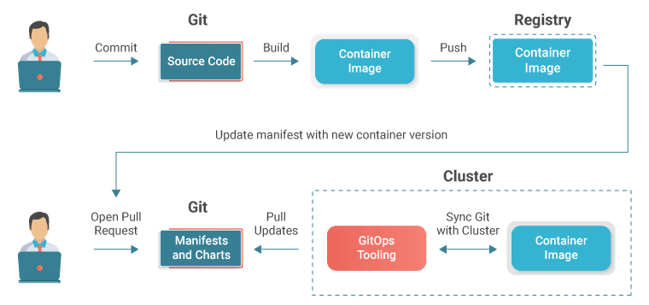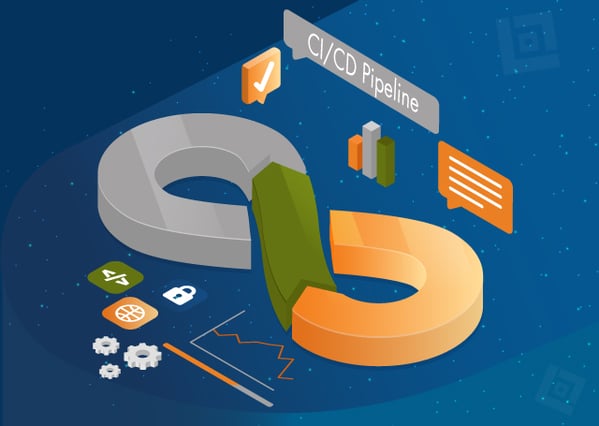The GitOps is an operational framework that takes DevOps finest practices used for development such as collaboration, compliance, version control, and CI/CD, and applies them to infrastructure automation.

There was a time when enterprises faced severe challenges in managing cloud infrastructure. The internal processes were plagued with inefficient deployment pipelines dependent on manual processes. It was causing extensive integration problems and delays in product deployment. Then came the concept of GitOps. Companies have started implementing continuous deployment for cloud-native applications via GitOps. It helps simplify cloud-native application deployment and improve infrastructure automation in real-time.
What is GitOps?

GitOps is a set of tools that provides a framework for DevOps practices to automate the processes of infrastructure provisioning, configuration management, version control, continuous integration, and deployment.
With the GitOps approach, Git (a version control system to track changes in any set of files or source code) is used to version and store the infrastructure configuration files.
A Git repository such as GitHub, Bitbucket, or GitLab is the single source for infrastructure running across different environments (development, staging, and production).
GitOps is neither infrastructure-as-code (IaC) nor a CI/CD. It plays a role in both. Once a configuration file is committed to Git, GitOps feeds the CI/CD pipeline, automating the delivery of the infrastructure to different environments (development, staging, production, etc).
Why Do We Need the GitOps Approach?
The past few years have seen the rapid growth of software development, which has necessitated enterprises to migrate from legacy infrastructure to modern infrastructure management platforms. Since legacy processes were mainly managed manually, it caused a lot of delays in SDLC, thereby increasing the problems in infrastructure deployments and management.
To address these issues, the software development teams started identifying and automating standard processes and configurations by writing programmatic scripts (like- Bash/Powershell/Pearl/Python). However, not all problem areas can be addressed by just writing programmatic scripts.
Following this, configuration management tools came into play. These tools used a code-based approach to configure and manage infrastructure. This makes it easier to manage and operate application infrastructure at scale with fewer efforts. Again, some parts, like the infrastructure provisioning in the data centers or cloud platforms, were still manual or partially automated. In the next phase of this infrastructure automation, evolution, development teams will focus on writing infrastructure as code.
With continuous integration and continuous delivery (CI/CD) pipelines, hundreds of code changes are processed daily. For instance, changes made to a build before or after being deployed to an environment. The infrastructure and configuration may need to be updated frequently, leading to configuration inconsistencies and hours of troubleshooting. These challenges led the DevOps teams to adopt GitOps to standardize configuration and application deployment.
The GitOps approach can be used with any infrastructure that can be declaratively managed.

How Does GitOps Work?
The functionality of GitOps can be explained with the help of the following workflow for Kubernetes:

The process can be divided into four phases
-
Phase-1: Commit Code Changes
The developers commit changes to the code in the Git repository, and a commit always creates artifacts. In this case, a new image will be built and created.
-
Phase-2: Deploy Configurations for the Application
In the case of Kubernetes, we are defining the deployment and other associated changes in the manifest files written in YML format. The manifest files include the definitions of how to map ports, services, environment variables, config maps, secrets, and configuration options for the image. This will ultimately be the desired state of an application.
-
Phase-3: Application or Infrastructure Deployment
The GitOps agent monitors every change committed to the Git repository. This step monitors the application and compares it to the current state against the desired state specified in the Git repository. If any change is found in the Git repository, it rolls out the changes in the infrastructure accordingly.
-
Phase-4: Image Deployment
The image is then rolled out across the different environments (staging and production).
Many different tools are used together to build a GitOps framework. Some of the examples include Git repositories (GitHub), Kubernetes, continuous integration/continuous delivery (CI/CD) (GitHub Actions) tools, configuration management tools (SaltStack), and infrastructure as code (IaC) (Terraform).
An Example of GitOps Tooling
Services Tools |
Names (Examples) |
|---|---|
| Version control system | Git |
| Git management tool | Bitbucket, GitHub, GitLab |
| CI/CD tools | Circle CI, Jenkins, GitHub Actions |
| Container registry | Docker Hub, ECR |
| Configuration management | Ansible, Chef |
| Infrastructure provisioning | AWS Cloud Formation, Terraform |
| Container orchestration | Kubernetes |
Challenges That Can Occur Without the Gitops Approach

- Manual and Error-Prone Deployments: Without GitOps, deployments are often manual, increasing the risk of human error. Configuration drift between development, testing, and production environments can lead to unexpected issues.
- Lack of Version Control: Traditional deployment methods may lack version control for infrastructure and application configurations, making it difficult to track changes, roll back to previous states, or collaborate effectively.
- Inconsistent Environments: Without a GitOps approach, different environments (e.g., development, staging, and production) may become inconsistent, leading to problems with testing and validation.
- Complex and Time-Consuming Rollbacks: In case of issues or failures, rolling back to a stable state can be complex and time-consuming, potentially resulting in extended downtime.
- Security Risks: Lack of automation and proper configuration management can introduce security vulnerabilities, misconfigurations, and unauthorized changes to the infrastructure.
Case Study: Challenges in Deployment for a Technology Company
 Problem
Problem
A technology company encountered issues related to their deployment processes, including inconsistencies across different environments (development, staging, and production). These disparities led to manual deployment errors and unexpected issues during the deployment phase.
 Solutions
Solutions
To address these challenges, the company implemented a robust solution that incorporated automated deployment pipelines, GitOps configuration management practices, and infrastructure as code (IaC) principles.
The company introduced automated deployment pipelines that leveraged GitOps configuration management practices. This approach automated the building, testing, and deployment of their application to the production environment. By adopting GitOps, they achieved a high level of consistency in deployments and effectively eliminated the manual errors that had previously plagued their deployment processes.
In addition to the GitOps practices, the company embraced IaC to ensure consistent configurations across all their environments. This effort aimed to make sure that their development, staging, and production environments were identical, thus reducing unexpected issues during the deployment phase. By managing infrastructure as code, they could define and maintain their environments through code, making it easier to keep configurations consistent and up-to-date.
The company also implemented GitOps testing to validate these configurations. This testing approach ensured that their environments remained consistent and allowed them to catch any discrepancies before they could cause problems during deployment. As a result, their deployments became more reliable, with fewer surprises and issues.
This technology company successfully addressed its deployment challenges by combining automated deployment pipelines, GitOps, and IaC principles. This comprehensive solution eliminated manual errors and ensured consistent and identical environments across development, staging, and production, leading to more reliable deployments.
Benefits of the GitOps Approach
Let us discuss some advantages of the GitOps approach
Simplified infrastructure management
The GitOps approach automates infrastructure management as part of DevOps practices. The infrastructure configuration is incorporated within the CI/CD pipeline.
Faster deployments and increased productivity
Continuous deployment of controlled infrastructure reduces configuration errors. This results in faster and more frequent deployments.
Strong Security
GitOps helps organizations enforce security best practices, such as discovering bugs at an early stage. It also allows developers to automate and manage infrastructure as code declaratively.
Stable Infrastructure
The GitOps approach eliminates human error, so the infrastructure becomes stable and readily available all the time.
Conclusion
The GitOps approach standardizes the configuration and application deployment across different environments (development, staging, and production). The GitOps approach can be used with any infrastructure that can be declaratively managed. The GitOps approach automates the management of infrastructure and configuration as a part of the DevOps practices, which results in simplified and stable infrastructure and faster deployments. If you are also looking for a customized and sustained DevOps solution, contact QASource now.
Have Suggestions?
We would love to hear your feedback, questions, comments and suggestions. This will help us to make us better and more useful next time.
Share your thoughts and ideas at knowledgecenter@qasource.com



